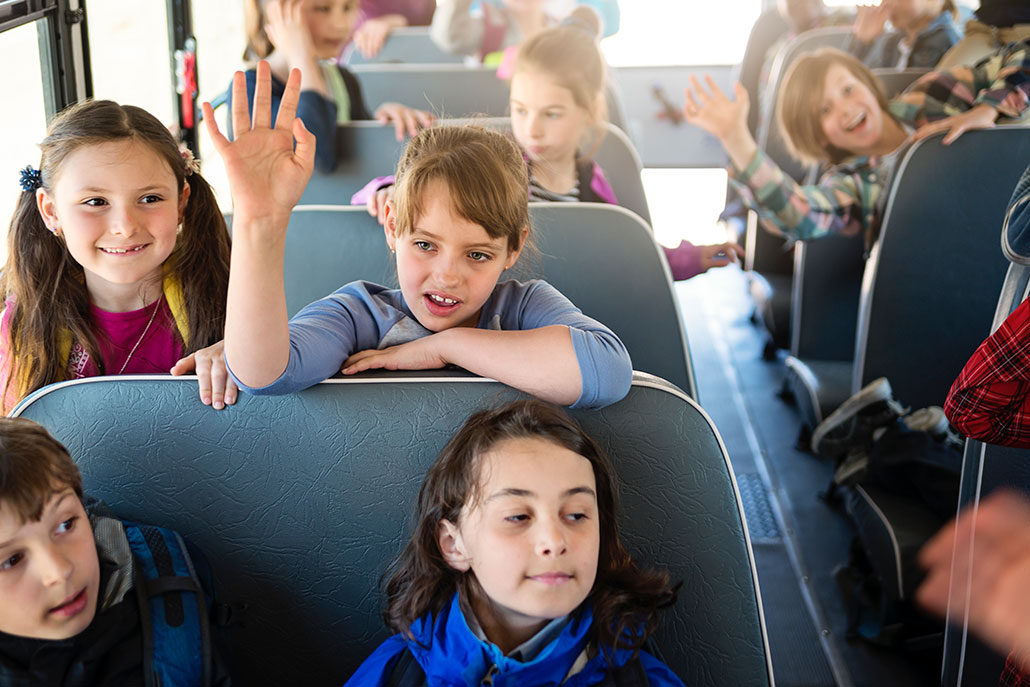Older diesel school buses linked to more student absences
Upgrading these higher-polluting buses boosts kids’ class time, a new study finds

Many school districts won rebates to replace or upgrade old diesel school buses. The goal: to reduce kids’ exposure to pollution. Student attendance improved in schools that upgraded their buses, suggesting that they kept kids healthier.
lisagagne/E+/Getty Images Plus
Each year, more than 27 million U.S. and Canadian kids get to school by bus. Most of those buses run on diesel fuel. Diesel buses spew pollution that riders can inhale. Replacing older, more-polluting, diesel buses should cut down on student absences, a new study finds.
Researchers shared their findings April 10 in Nature Sustainability.
Diesel pollution includes tiny aerosols. The buses also spit out gases, such as nitrogen oxides. Studies have linked aerosols and nitrogen oxides to breathing problems, such as asthma. Aerosol pollution also has been linked to problems with heart health, learning and more. (Diesel emissions also contribute to global warming.)
Pollution levels can be several times higher inside a diesel school bus than outside it. Why? Pollution can leak in from the floor or blow in through windows.
The new study focused on schools that asked to take part in a U.S. government program. The program offered schools a rebate — cash back — for money spent on cleaner school buses. The 2,816 school districts in the new study all asked for the rebates. But not all got them. They were put into a random lottery. Only 383 got picked to receive funding. Winning districts could buy new buses and scrap old ones. Or they could add new pollution controls to existing buses. Most bought new buses.
The program started in 2012. From 2012 to 2017, emissions from buses in the winning districts fell. And a year after getting new buses, student attendance had improved in those districts. It went up by 0.06 percentage point more, on average, than in the losing districts.
The randomly picked rebate winners “let us truly talk about the causative impacts,” says Meredith Pedde. She’s an environmental epidemiologist — a disease detective — at the University of Michigan in Ann Arbor. Pedde led the new study.
For an average district of 10,000 students, about six more students attended school each day in the winning districts, compared to the losing districts.

Winning schools with higher rates of bus-riding kids had an average of 14 more students in class each day. And winning districts that replaced the oldest school buses? They had an average of 45 more students in school each day.
Those numbers may sound small, but they add up. And school attendance matters for student achievement, Pedde says. Almost 3 million U.S. kids ride school buses more than 20 years old, her team figures. If U.S. school districts had replaced all of those older buses, there would have been 1.3 million fewer student absences each year, the data suggest.
In fact, the new study may understate the benefits of replacing the old buses. Consider one small January study done on adults. In it, brain scans showed that a brief exposure to diesel emissions diminished “network connectivity” in the brain. In other studies, such network-connectivity changes have been linked to worsened memory and mental tasks.
Investing in health
“This is a great study,” says Jay Shimshack about the work by Pedde’s team. Shimshack is an economist at the University of Virginia in Charlottesville. The random selection of winners provided a “really compelling” way to draw true cause-and-effect links between the program’s effects and an outcome that people care about, he says.
Pedde’s team didn’t rule out all other reasons for better attendance. For example, maybe kids preferred new buses. However, Shimshack said, work by his team and others suggests the most likely reason for fewer student absences was better health.
In one 2011 study, Shimshack and a colleague focused on a Washington State program. It upgraded pollution controls in old diesel buses. Afterward, fewer kids were hospitalized for asthma and pneumonia in those districts than in schools without bus upgrades.
New buses in the rebate program studied by Pedde’s team gave off less pollution than older ones. But they were mostly diesel buses that still spit out some pollution.

Now the U.S. Environmental Protection Agency (EPA) has a new rebate program for school buses. It’s offering $5 billion through 2026 to replace old diesel buses with electric buses. Or districts can buy ones that run on cleaner fuels, such as propane or compressed natural gas.
Almost all U.S. school districts can apply for the new rebates. But schools in low-income areas, in tribal areas and in rural areas will get priority. Kids in these areas tend to face the most health risks from older buses, EPA notes. In April, the Canadian Partnership for Children’s Health and Environment also called for replacing diesel buses with electric ones.
Future studies might look at specific diesel effects on health, Shimshack suggests, such as rates of asthma or other conditions. They might also look for differences in how kids perform in school. For now, anything that reduces air pollution will likely improve student health, Pedde says. There’s no threshold, she says, “below which we don’t see effects.”







